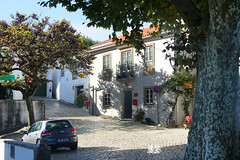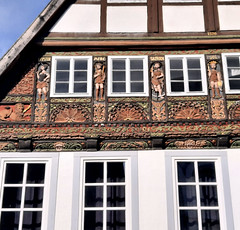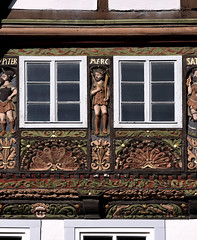Championnat régional Fond de Canoë-Kayak au lac de Créteil du | Flickr, ces 365 derniers jours
Championnat régional Fond de Canoë-Kayak au lac de Créteil du 12 mars 2017
vendredi 13 octobre 2023
jeudi 12 octobre 2023
-
Number 24
Eric@focus has added a photo to the pool:

-
Hamburg: Treppenabsatz im Chilehaus - Stair landing in the Chile House
riesebusch has added a photo to the pool:

Das Chilehaus ist ein von 1922 bis 1924 erbautes Kontorhaus im Hamburger Kontorhausviertel. Die Architektur von Fritz Höger war beispielgebend für den Backsteinexpressionismus der 1920er Jahre, der von Backsteingotik und Expressionismus inspiriert war. Der Bau stellt mit seinen 36.000 m² Bruttogeschossfläche und bis zu zehn Stockwerken auf einer Grundfläche von 5950 m² eines der ersten Hamburger Hochhäuser dar. Mit seiner an einen Schiffsbug erinnernden Spitze nach Osten ist es zu einer Ikone des Expressionismus in der Architektur geworden. Das Kontorhausviertel befindet sich im südöstlichen Bereich der Hamburger Altstadt und besteht aus großen, bis zu zehngeschossigen Kontorhäusern im Stil des Backsteinexpressionismus und anderer moderner Stilrichtungen des frühen 20. Jahrhunderts. Das Viertel entstand zwischen dem Ersten und Zweiten Weltkrieg unter der Gesamtplanung des damaligen Hamburger Oberbaudirektors Fritz Schumacher. Der zentrale Teil des Kontorhausviertels rund um den Burchardplatz wurde am 5. Juli 2015 zusammen mit der benachbarten Speicherstadt zum UNESCO-Weltkulturerbe Speicherstadt und Kontorhausviertel mit Chilehaus erklärt
Informationen basierend auf Wikipedia
The Chile House is an office building built from 1922 to 1924 in Hamburg's Kontorhausviertel (Office Building) District. The architecture by Fritz Höger was exemplary for the brick expressionism of the 1920s, which was inspired by brick Gothic and expressionism. With its 36,000 m² of gross floor space and up to ten storeys on a floor area of 5950 m², the building represents one of Hamburg's first high-rise buildings. With its pointed end to the east, reminiscent of a ship's prow, it has become an icon of expressionism in architecture. The Kontorhausviertel is located in the south-eastern area of Hamburg's old town and consists of large, up to ten-storey office buildings in the style of brick expressionism and other modern styles of the early 20th century. The quarter was built between the First and Second World Wars under the overall planning of Fritz Schumacher, Hamburg's chief building director at the time. The central part of the Kontorhausviertel around Burchardplatz, together with the neighbouring Speicherstadt ("Warehouse City"), was declared a UNESCO World Heritage Site on 5 July 2015.
Information based on Wikipedia
-
Hamburg: Einer der Eingänge des Chilehauses - Entrance A of the Chile House
riesebusch has added a photo to the pool:

Das Chilehaus ist ein von 1922 bis 1924 erbautes Kontorhaus im Hamburger Kontorhausviertel. Die Architektur von Fritz Höger war beispielgebend für den Backsteinexpressionismus der 1920er Jahre, der von Backsteingotik und Expressionismus inspiriert war. Der Bau stellt mit seinen 36.000 m² Bruttogeschossfläche und bis zu zehn Stockwerken auf einer Grundfläche von 5950 m² eines der ersten Hamburger Hochhäuser dar. Mit seiner an einen Schiffsbug erinnernden Spitze nach Osten ist es zu einer Ikone des Expressionismus in der Architektur geworden. Das Kontorhausviertel befindet sich im südöstlichen Bereich der Hamburger Altstadt und besteht aus großen, bis zu zehngeschossigen Kontorhäusern im Stil des Backsteinexpressionismus und anderer moderner Stilrichtungen des frühen 20. Jahrhunderts. Das Viertel entstand zwischen dem Ersten und Zweiten Weltkrieg unter der Gesamtplanung des damaligen Hamburger Oberbaudirektors Fritz Schumacher. Der zentrale Teil des Kontorhausviertels rund um den Burchardplatz wurde am 5. Juli 2015 zusammen mit der benachbarten Speicherstadt zum UNESCO-Weltkulturerbe Speicherstadt und Kontorhausviertel mit Chilehaus erklärt
Informationen basierend auf Wikipedia
The Chile House is an office building built from 1922 to 1924 in Hamburg's Kontorhausviertel (Office Building) District. The architecture by Fritz Höger was exemplary for the brick expressionism of the 1920s, which was inspired by brick Gothic and expressionism. With its 36,000 m² of gross floor space and up to ten storeys on a floor area of 5950 m², the building represents one of Hamburg's first high-rise buildings. With its pointed end to the east, reminiscent of a ship's prow, it has become an icon of expressionism in architecture. The Kontorhausviertel is located in the south-eastern area of Hamburg's old town and consists of large, up to ten-storey office buildings in the style of brick expressionism and other modern styles of the early 20th century. The quarter was built between the First and Second World Wars under the overall planning of Fritz Schumacher, Hamburg's chief building director at the time. The central part of the Kontorhausviertel around Burchardplatz, together with the neighbouring Speicherstadt ("Warehouse City"), was declared a UNESCO World Heritage Site on 5 July 2015.
Information based on Wikipedia
-
Ourém
hans pohl has added a photo to the pool:

Ourém, Tomar, Portugal
mercredi 11 octobre 2023
mardi 10 octobre 2023
lundi 9 octobre 2023
-
Hamburg: Hauptkirche St. Jacobi, Gotische Tür im Altarraum - St. James' Main Church, Gothic door in the Chancel
riesebusch has added a photo to the pool:

Die Sankt-Jacobi-Kirche ist eine der fünf evangelisch-lutherischen Hauptkirchen Hamburgs. Trotz vieler Veränderungen im Laufe der Geschichte und massiver Zerstörungen im Zweiten Weltkrieg ist die Kirche einer der wenigen erhaltenen mittelalterlichen Bauten in der Stadtmitte. St. Jacobi ging aus einer Kapelle an einem Jakobsweg hervor. Deshalb wurde die Kirche dem Apostel Jakobus geweiht. Bei der ersten Erwähnung 1255 lag St. Jacobi noch außerhalb der gesicherten Stadt. Der Hauptteil der Kirche geht auf einen Neubau im 14. Jahrhundert zurück: Zwischen 1350 und etwa 1400 baute man eine dreischiffige Hallenkirche im gotischen Stil, ähnlich der benachbarten Petrikirche
St. James' Church is one of the five main Protestant-Lutheran churches in Hamburg. Despite many changes throughout history and massive destruction during the Second World War, the church is one of the few remaining medieval buildings in the city centre. St. Jamesi originated from a chapel on a Way of St. James. Therefore, the church was dedicated to St. James. When it was first mentioned in 1255, St. James' was still outside the secured town. The main part of the church dates back to a new building in the 14th century: between 1350 and about 1400, a three-nave hall church was built in the Gothic style, similar to the neighbouring church of St. Peter.
-
Brookland, Kent, St. Augustine's Church, exterior, detail
groenling has added a photo to the pool:

The church is from ~1250 ; the freestanding wooden tower from ~1260 tho originally much simpler.
dimanche 8 octobre 2023
-
Lemgo, Westfalen, Planetenhaus {1576}, detail
groenling has added a photo to the pool:

Mittelstraße
-
Lemgo, Westfalen, Planetenhaus {1576}, detail
groenling has added a photo to the pool:

Mittelstraße
-
Lemgo, Westfalen, Planetenhaus {1576}, detail
groenling has added a photo to the pool:

Mittelstraße
-
Lemgo, Westfalen, Planetenhaus {1576}, detail
groenling has added a photo to the pool:

Mittelstraße
-
Lemgo, Westfalen, Planetenhaus {1576}, detail
groenling has added a photo to the pool:

Mittelstraße
jeudi 28 septembre 2023
mardi 5 septembre 2023






vendredi 13 octobre 2023
@nn@. has added a photo to the pool:
Poso la fronte sulla finestra in cerca di sicurezza e lei mi risponde: “Possa non mancarti mai il cielo”.
Fabrizio Caramagna
jeudi 12 octobre 2023
Eric@focus has added a photo to the pool:
riesebusch has added a photo to the pool:
Das Chilehaus ist ein von 1922 bis 1924 erbautes Kontorhaus im Hamburger Kontorhausviertel. Die Architektur von Fritz Höger war beispielgebend für den Backsteinexpressionismus der 1920er Jahre, der von Backsteingotik und Expressionismus inspiriert war. Der Bau stellt mit seinen 36.000 m² Bruttogeschossfläche und bis zu zehn Stockwerken auf einer Grundfläche von 5950 m² eines der ersten Hamburger Hochhäuser dar. Mit seiner an einen Schiffsbug erinnernden Spitze nach Osten ist es zu einer Ikone des Expressionismus in der Architektur geworden. Das Kontorhausviertel befindet sich im südöstlichen Bereich der Hamburger Altstadt und besteht aus großen, bis zu zehngeschossigen Kontorhäusern im Stil des Backsteinexpressionismus und anderer moderner Stilrichtungen des frühen 20. Jahrhunderts. Das Viertel entstand zwischen dem Ersten und Zweiten Weltkrieg unter der Gesamtplanung des damaligen Hamburger Oberbaudirektors Fritz Schumacher. Der zentrale Teil des Kontorhausviertels rund um den Burchardplatz wurde am 5. Juli 2015 zusammen mit der benachbarten Speicherstadt zum UNESCO-Weltkulturerbe Speicherstadt und Kontorhausviertel mit Chilehaus erklärt
Informationen basierend auf Wikipedia
The Chile House is an office building built from 1922 to 1924 in Hamburg's Kontorhausviertel (Office Building) District. The architecture by Fritz Höger was exemplary for the brick expressionism of the 1920s, which was inspired by brick Gothic and expressionism. With its 36,000 m² of gross floor space and up to ten storeys on a floor area of 5950 m², the building represents one of Hamburg's first high-rise buildings. With its pointed end to the east, reminiscent of a ship's prow, it has become an icon of expressionism in architecture. The Kontorhausviertel is located in the south-eastern area of Hamburg's old town and consists of large, up to ten-storey office buildings in the style of brick expressionism and other modern styles of the early 20th century. The quarter was built between the First and Second World Wars under the overall planning of Fritz Schumacher, Hamburg's chief building director at the time. The central part of the Kontorhausviertel around Burchardplatz, together with the neighbouring Speicherstadt ("Warehouse City"), was declared a UNESCO World Heritage Site on 5 July 2015.
Information based on Wikipedia
riesebusch has added a photo to the pool:
Das Chilehaus ist ein von 1922 bis 1924 erbautes Kontorhaus im Hamburger Kontorhausviertel. Die Architektur von Fritz Höger war beispielgebend für den Backsteinexpressionismus der 1920er Jahre, der von Backsteingotik und Expressionismus inspiriert war. Der Bau stellt mit seinen 36.000 m² Bruttogeschossfläche und bis zu zehn Stockwerken auf einer Grundfläche von 5950 m² eines der ersten Hamburger Hochhäuser dar. Mit seiner an einen Schiffsbug erinnernden Spitze nach Osten ist es zu einer Ikone des Expressionismus in der Architektur geworden. Das Kontorhausviertel befindet sich im südöstlichen Bereich der Hamburger Altstadt und besteht aus großen, bis zu zehngeschossigen Kontorhäusern im Stil des Backsteinexpressionismus und anderer moderner Stilrichtungen des frühen 20. Jahrhunderts. Das Viertel entstand zwischen dem Ersten und Zweiten Weltkrieg unter der Gesamtplanung des damaligen Hamburger Oberbaudirektors Fritz Schumacher. Der zentrale Teil des Kontorhausviertels rund um den Burchardplatz wurde am 5. Juli 2015 zusammen mit der benachbarten Speicherstadt zum UNESCO-Weltkulturerbe Speicherstadt und Kontorhausviertel mit Chilehaus erklärt
Informationen basierend auf Wikipedia
The Chile House is an office building built from 1922 to 1924 in Hamburg's Kontorhausviertel (Office Building) District. The architecture by Fritz Höger was exemplary for the brick expressionism of the 1920s, which was inspired by brick Gothic and expressionism. With its 36,000 m² of gross floor space and up to ten storeys on a floor area of 5950 m², the building represents one of Hamburg's first high-rise buildings. With its pointed end to the east, reminiscent of a ship's prow, it has become an icon of expressionism in architecture. The Kontorhausviertel is located in the south-eastern area of Hamburg's old town and consists of large, up to ten-storey office buildings in the style of brick expressionism and other modern styles of the early 20th century. The quarter was built between the First and Second World Wars under the overall planning of Fritz Schumacher, Hamburg's chief building director at the time. The central part of the Kontorhausviertel around Burchardplatz, together with the neighbouring Speicherstadt ("Warehouse City"), was declared a UNESCO World Heritage Site on 5 July 2015.
Information based on Wikipedia
hans pohl has added a photo to the pool:
Ourém, Tomar, Portugal
mercredi 11 octobre 2023
tupacarballo has added a photo to the pool:
mardi 10 octobre 2023
CloR13 has added a photo to the pool:
Couleurs d'automne
threejumps has added a photo to the pool:
Crete
threejumps has added a photo to the pool:
Crete
Willy Verhulst has added a photo to the pool:
Spain
lundi 9 octobre 2023
riesebusch has added a photo to the pool:
Die Sankt-Jacobi-Kirche ist eine der fünf evangelisch-lutherischen Hauptkirchen Hamburgs. Trotz vieler Veränderungen im Laufe der Geschichte und massiver Zerstörungen im Zweiten Weltkrieg ist die Kirche einer der wenigen erhaltenen mittelalterlichen Bauten in der Stadtmitte. St. Jacobi ging aus einer Kapelle an einem Jakobsweg hervor. Deshalb wurde die Kirche dem Apostel Jakobus geweiht. Bei der ersten Erwähnung 1255 lag St. Jacobi noch außerhalb der gesicherten Stadt. Der Hauptteil der Kirche geht auf einen Neubau im 14. Jahrhundert zurück: Zwischen 1350 und etwa 1400 baute man eine dreischiffige Hallenkirche im gotischen Stil, ähnlich der benachbarten Petrikirche
St. James' Church is one of the five main Protestant-Lutheran churches in Hamburg. Despite many changes throughout history and massive destruction during the Second World War, the church is one of the few remaining medieval buildings in the city centre. St. Jamesi originated from a chapel on a Way of St. James. Therefore, the church was dedicated to St. James. When it was first mentioned in 1255, St. James' was still outside the secured town. The main part of the church dates back to a new building in the 14th century: between 1350 and about 1400, a three-nave hall church was built in the Gothic style, similar to the neighbouring church of St. Peter.
groenling has added a photo to the pool:
The church is from ~1250 ; the freestanding wooden tower from ~1260 tho originally much simpler.
dimanche 8 octobre 2023
groenling has added a photo to the pool:
Mittelstraße
groenling has added a photo to the pool:
Mittelstraße
groenling has added a photo to the pool:
Mittelstraße
groenling has added a photo to the pool:
Mittelstraße
groenling has added a photo to the pool:
Mittelstraße
jeudi 28 septembre 2023
godran25 has added a photo to the pool:
Tourelle d'escalier en attente de restauration
mardi 5 septembre 2023
kasmil has added a photo to the pool:
kasmil has added a photo to the pool: